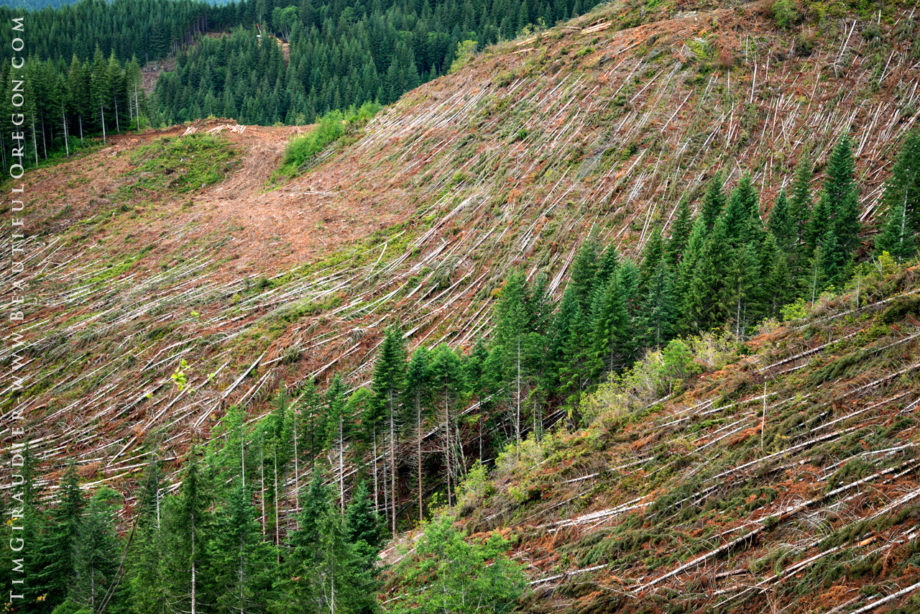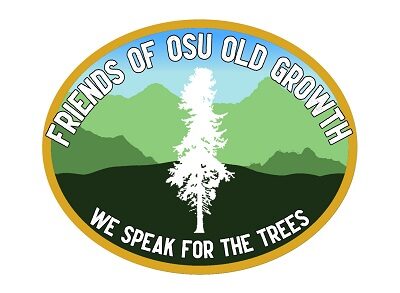
Creating a Positive Future for the Elliott State Research Forest (ESRF): It’s important to be aware of the history and shortcomings of both OSU’s forest management and the Elliott process so we can choose a more positive path going forward. I’ve provided an update on the Elliott process and lots of relevant information in lower half of this post. You can find guidance on what to advocate for and how to do it in the first two sections below.
Elliott State Research Forest Requirements: We urge the Elliott Advisory Committee, OSU, and the State Land Board to abide by the following principles in the ESRF proposal:
1) Independent Oversight Focused on Research: Oversight of the Elliott State Research Forest must be free of OSU control (which has deep industry funding and influence). The governing body of the ESRF should be chosen by our elected leaders with a primary focus on the research mission.
2) Carbon-, Wildlife- and Ecological Research Must Come First: Most of the Coast Range forests have already been decimated by industrial logging. Oregonians overwhelmingly support protection of the unique natural resources of the Elliott. Research should not be focused on the impacts of logging, but rather restoration and enrichment of the natural environment. With industrial forests operating on ~40-year rotations, there is no justification for cutting significantly older trees in the ESRF.
3) Public Participation and Trust is Key: The Elliott State Forest is a public resource, shared by all Oregonians. If it becomes a “Research Forest” managed by OSU, it is critical that the public be a key partner in the oversight and use of the Forest. The governing body must include public representation, and a process for gathering and responding to public input.
4) Independent Assessment Provides Accountability: Regardless of the governance structure, there must be a periodic, independent audit of the management of the ESRF. The results of the audit must be made available to the public, and used to ensure operations are consistent with the research mission.
How to Provide Feedback: The Department of State Lands (DSL) has only allocated 3-1/2 weeks for public outreach and feedback on the Elliott State Research Forest Proposal. Given the lack of transparency and the long, contentious history of the ESF, this short communication period is completely inadequate. To learn more and share your input about the Elliott State Research Proposal, visit DSL’s outreach page.
The public can submit comments by:
- using DSL’s online form: https://forms.dsl.state.or.us/Forms/ElliottStateForest
- sending an email to: Ali.R.Hansen@dsl.state.or.us
Update 11/11/20: In response to blistering criticism, DSL has extended the deadline for public comments to 5 p.m. on Sunday, November 29th.
Next Steps: The next meeting of the Elliott Advisory Committee is scheduled for Thursday, November 19th, 2020. Since this is the last scheduled meeting of the committee, it will likely be very busy and contentious. The Oregon Land Board (composed of the Governor, Secretary of State, and Treasurer) is expected to meet on December 8th, 2020, to consider the Proposal. Both meetings will be open to the public (via Zoom video link). To make sure you’re on the DSL mailing list, sign up at this link: https://www.oregon.gov/DSL/News/Pages/Subscribe.aspx
Background: In my blog piece from December, 2019, (The OSU- Elliott Problem…), I expressed concerns about OSU’s proposal for turning Oregon’s Elliott State Forest into what will likely become one of the largest research forests in the United States. Fast forward to September 28th, 2020, when OSU staff (under the leadership of their new Dean of the College of Forestry, Tom DeLuca) met with the Elliott Advisory Committee and Oregon Department of State Lands (DSL) staff in a video conference that was open to the public (but not available for subsequent viewing). If you were lucky enough to hear about the meeting in advance, you were able to witness significant friction and some unsettling developments.
Pressure from the Top: The meeting started off with an ominous message from the DSL Director, Vicki Walker: if agreement cannot be reached, logging of the Elliott State Forest will resume. She also chided those who feel more time is needed to iron out critical details, saying time and again that the Land Board MUST have a final proposal in time for their December 8th meeting. Several members of the Advisory Committee expressed their reservations about the rushed schedule. Key financial information has yet to be presented by OSU, and work on OSU’s governance proposal had only just begun (more on that controversy below). It was hard to miss the sense of disconnect when Director Walker insisted, “We’re almost there on the governance!“. When asked whether any legislative action was anticipated, she replied, “We have a bill…we have a bill...”, leaving everyone with more questions than answers.
Concerns over ODF vs. OSU Murrelet Data: Committee member Bob Sallinger (Portland Audubon Society) provided some truly heroic push-back on a number of issues, leaving the conservation-minded folks wondering where we’d be without his leadership. Bob discussed recent revelations that OSU’s research proposal for the Elliott had been based on Oregon Department of Forestry (ODF) data for marbled murrelets, not the extensive research findings of OSU’s own murrelet experts. The murrelet data set (ODF vs. OSU or some combination of the two) plays THE critical role in determining which areas of the Forest are off-limits to logging. If data from the OSU researchers is more recent and extensive, it raises questions about the original choice of data set and which areas of the Elliott OSU plans to protect. Surely the OSU Elliott team must have understood the enormous implications of the murrelet data choice and how it would impact their research plan. Dean DeLuca assured everyone that there was no hidden agenda, and that OSU’s adaptive management plan would allow them to continue refining their research approach. Just how this might work in practice remains unclear.
OSU’s Self-Governance Proposal: For me, the most disturbing aspect of the meeting was OSU’s proposal for self-governance of the Elliott State Research Forest – which fails to take into account the long history of bias and mismanagement of OSU’s existing Research Forests. Management of the ESRF would rely on several oversight entities, all of them chosen or controlled by OSU. The ultimate oversight responsibilities would fall on the OSU Board of Trustees – an entity that has shown itself to be decidedly unwilling and unqualified to deal with forestry issues (as well as ethics violations by College leaders – for details read my previous blog piece: “Trust Issues: OSU’s Self-Governance Plans for the Elliott State Forest“). Anyone who has followed OSU’s management of their existing Research Forests can tell you about the pitfalls of their long history of self-governance! The cutting of old growth in 2019, repeated violations of their 2005 Research Forest Plan, destruction of northern spotted owl habitat, a 10-year lapse in both their forest inventory and adherence to their own management plan – have all eroded public trust in OSU’s ability to manage their Research Forests.
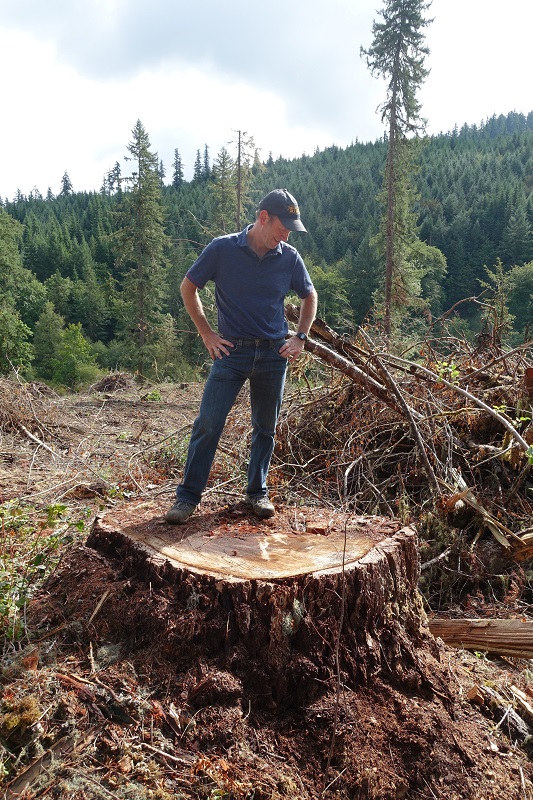
Lack of Transparency Excludes Public: I’ve alluded to the lack of transparency within the Elliott process many times in the past, but it’s worth reviewing these concerns in more detail. When I first learned of OSU’s draft report on financial and carbon modeling for the Elliott in October of last year, I wondered why it was not available on either the OSU or DSL website. This 46-page report was the key planning document outlining the details of OSU’s proposed logging scenarios for the Elliott. Insiders reported that OSU’s preferred alternative (“Scenario B”) would involve cutting thousands of acres of older forest in the coming decades.
After the report was shared with the Elliott Advisory Committee (at their October 25th, 2019, meeting), I began sending emails to DSL staff asking why this important document had not been made available to the public. After weeks of delay and escalating requests, the report finally showed up in the document link for the October meeting. By not providing this report in a timely manner, DSL staff had deprived the public of their right to know these important details. Information has a shelf-life, and the delay in providing it diminishes its relevance.
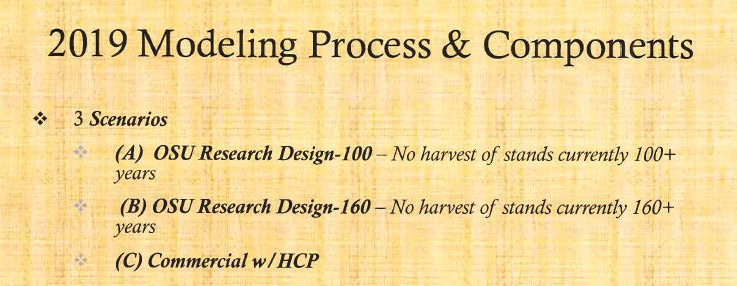
A more recent example concerns the unwillingness of DSL staff to make the video of the Sept. 28th Elliott Advisory Committee available to the public (a relatively simple task with a Zoom video conference). After the meeting, it took weeks for DSL staff to post a meeting summary. While the written summary is helpful, it is no substitute for the actual recording of the meeting. A written summary always conveys the biases and choices of the writer, inviting criticism and suspicion. The video recording would allow people who missed the meeting to watch it later, while also providing an authentic record of comments and presentations. It seems contrary to DSL’s obligation to the public to NOT release the video recording of the meeting.
Language of Draft Plan Betrays Bias: The lack of transparency in the Elliott process has been made worse by the technical language and complexity of the planning documents. They are rife with undefined acronyms and jargon that seem designed to obscure just how much of the older forests will be cut. Reed Wilson of the Benton Forest Coalition provided an excellent analysis of the loaded language of OSU’s draft plan for the ESRF:

The authors of OSU’s plans for the ESRF would do well to rethink and overhaul the fundamental structure and language of their proposal. Even experienced forestry experts find it difficult to interpret just how much of the older forest will be cut under the confusing mix of alternatives.
Research Justification Needs Clarification: OSU’s draft plan and modeling documents for the Elliott from October, 2019, included a wealth of information about the age classes of trees that would be cut under various “management” scenarios. OSU’s preferred alternative (shown as “Scenario B” in Fig. A, above) would have cut thousands of acres of older trees. At the December, 2019, Land Board meeting, the public joined OSU’s own alumni and ecological forestry experts, Norm Johnson and Jerry Franklin, in condemning the cutting of older trees proposed in the OSU plan.
Curiously, nearly all references to cutting older trees have been removed from OSU’s current draft plan for the ESRF. There are no graphs or charts showing how much of each age class would be cut under the various “treatments”. It appears that the OSU team figured out that references to cutting older trees gets the public all riled up, so they removed them from their proposal. Whether or not it was designed to deceive, this move invites criticism from an already-skeptical public.
Clues about the fate of older trees in the Elliott can be found by carefully examining the wording of OSU’s draft plan. The description of “extensive treatments” (Page 20), explains that 20 to 80% of the trees will be cut, and this may be applied to sections of forest that are up to ~150 years old. The total amount of older forest that would be cut is unclear, though experts tell me it is likely between 3,400 and 4,000 acres. To put that in perspective, that’s the equivalent of 85 to 100 40-acre clearcuts, a little smaller than OSU’s entire McDonald Research Forest, or nearly 1/2 the size of Corvallis.
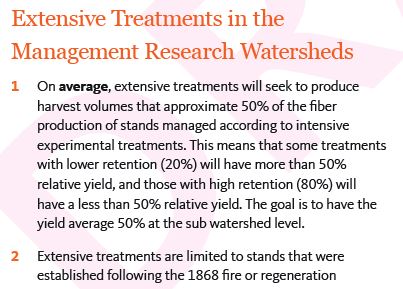
With the timber industry now relying almost entirely on short (~40-year) rotations, one wonders how OSU researchers can justify cutting significantly older trees in an Elliott State Research Forest. This type of “treatment” is fundamentally inconsistent with the ecological forestry management approach they are proposing for their “extensive” zones. Any research results they hope to obtain by thinning these older stands will have little or no relevance for industrial forestry practices. At the same time, the “intensive” zones (where clearcutting will rule) will just perpetuate the destructive practices and fragmentation of past logging. OSU should change the draft plan to show exactly how much of the older stands will be cut – and explain how cutting older trees has any ecological or research relevance.
Conflict of Interest Taints Process: When I reached out to the author of OSU’s key planning document last fall (Tom Tuchmann of US Forest Capital), he refused to answer even basic questions about his report (such as the meaning of undefined acronyms). An article in The Oregonian reported that Mr. Tuchmann attempted to purchase the Elliott State Forest on behalf of his investors in 2014. He also collected nearly $400,000 in his role as advisor for our previous Governor, John Kitzhaber – while running his consulting firm in an apparent conflict of interest. With his previous business interest in the Elliott and questionable ethics, I wonder why OSU leaders chose Mr. Tuchmann to develop their draft plan. As The Oregonian reported:
“Environmentalists, timber industry representatives and other policy advisers said Tuchmann’s twin roles made them uncomfortable and left them questioning his motives. That was especially true after Tuchmann proposed that his company put together a deal to buy state-owned forestland...Tuchmann also failed for two years to report any potential conflict of interest on state forms, records show…He already supported more logging than they were comfortable with…Our feeling was if Tom Tuchmann comes in as a private businessman and then as the governor’s adviser, whose interest is he representing at any given time and how were our answers filtering back through to the governor?“
Governor Brown severed Mr. Tuchmann’s contract the day she took office, saying:
“In terms of our path moving forward, the contract didn’t meet the direction we wanted to go in. Obviously, I’ve set forth my principles in terms of ethics, and I want to stick by them.” (The Oregonian/OregonLive)
If the ethical disparities were so clear to our current Governor, it makes one wonder why OSU would hire Mr. Tuchmann to be their lead consultant for the Elliott. The Oregonian reporter quoted Donald O. Neubaum (associate dean for research at OSU’s College of Business) as saying:
“Perceptions of fairness and ethical behavior are just as much about confidence in the process as they are about fairness of outcomes. If there is the potential for the appearance of unfairness in the process, it should be changed to make it more transparent or to reduce the perceived source of bias or unfairness.“
OSU leaders would do well to follow the advice of their own Associate Dean!
The gift of a $5 million endowment which pays the salary of the Dean of the College of Forestry raises more fundamental ethical questions. The primary donor, Allyn Ford, was the president and CEO of Roseburg Forest Products – a company that profited through logging of the Elliott State Forest, and tried to buy it in 2015. When the Deans who’ve presided over OSU’s Elliott process are funded by the owner of the company that profited from logging the forest (and will likely compete for future logging contracts) – it raises some uneasy questions.
